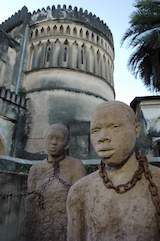
This kingdom and its inhabitants were known as the Swahili - the people of the coast. They traded gold, ivory and cloth with visitors from across the Indian Ocean, built handsome stone houses and had well-developed systems of government.
Envoys, merchants and even pirates from as far away as Japan and Russia came to Zanzibar and its environs in sailing ships, blown across the seas by the northeast monsoon and returning, their holds laden with trade goods, on the south-west wind.
The first Europeans to 'discover' Zanzibar were the Portuguese, who arrived in the late fifteenth century. In keeping with their conduct in the rest of their empire, they had little interest in the place beyond keeping it out of the hands of their enemies. They built a fort or two, introduced the sport of bullfighting to Pemba, and a few choice words into the Swahili language. In fact, the Portuguese words still in use in Kiswahili give a fairly good impression of how the Portuguese spent their time here: Meza - table. Mvinyo - wine. Pesa - money.
Chief among the trade visitors to Zanzibar were the Omani Arabs, who had developed one of the most powerful navies in the Indian Ocean, the centre of a thriving sea-going commercial empire. The Sultans of Oman accrued immense wealth by mounting slave-trading expeditions into the African interior, shipping their captives back to the Persian Gulf and selling them as household servants or plantation labourers.
It was Zanzibar that became the hub of this commercial empire, a handy storehouse for slaves fresh from the interior, who could be confined on the island until the ships which were to transport them north were made ready.
Sultan Seyyid Said
In 1828 the flagship of Sultan Seyyid Said, one of Oman's most powerful and influential rulers, landed at Zanzibar. The Sultan had previously been too busy defending Oman against its many would-be conquerors to visit the island in person, but he was enchanted by what he saw. In contrast to the dry, rocky desert of Oman, Zanzibar was green, lush and filled with sources of fresh water.
More importantly, it had strategic advantages - safe, defensible and closer to the African mainland, the source of his wealth. In 1840 Said moved his entire household to Zanzibar and declared it the new capital of his empire.
Said and his many relatives and associates built numerous palaces, bath houses and country manors on Zanzibar, and introduced the commercial farming of cloves, sugar and other crops. Said's empire went from strength to strength, fuelled all the time by the flow of miserable humanity that marched in chains from the regions of the great lakes and beyond, to be sold for ever higher prices in the great slave market in the middle of Stone Town.
But it couldn't last. By 1890, the British had put an end to the once-great empire of the Omani sultanate. By a combination of bribery, diplomacy and the odd judicious naval bombardment, Britain abolished the slave trade in East Africa and ultimately declared Zanzibar a protectorate. The then Sultan, Ali, became a British vassal, and between them, Britain and Germany carved up the Sultan's domains, which had once stretched as far inland as Lake Malawi. Although the sultans remained nominally on the throne, their power was ended and their wealth used up.
Revolution and Modern Day Zanzibar

The era of the British on Zanzibar, which saw the slave market destroyed and an Anglican cathedral built in its place, lasted until 1963, when power was formally handed back to the Omani sultans. But the reign of the new sultan was short-lived - he was ousted in 1964 by a violent revolution, and today lives quietly in a bungalow on the south coast of England.
After the revolution, the new Zanzibari government joined with the post-independence government of mainland Tanganyika to form a single state, renamed Tanzania. Zanzibar was run along socialist, single-party lines by the new revolutionary government, and received political support and financial aid from countries such as Bulgaria, East Germany and China.
However in the 1980s, the first presidential elections took place, and Zanzibar's economy slowly became less state-controlled, with some private sector enterprise being allowed. The first half of the 1990s saw the rise of a multi-party system of government and the development of Zanzibar's newest industry - tourism.

 Walking around Zanzibar's famous Stone Town is an architecture buff's delight – the variety of building styles on view provides a whistle-...
Walking around Zanzibar's famous Stone Town is an architecture buff's delight – the variety of building styles on view provides a whistle-... Zanzibar is actually the name given to a cluster of islands that nestle in the waters of the Indian Ocean just off the coast of mainland Tan...
Zanzibar is actually the name given to a cluster of islands that nestle in the waters of the Indian Ocean just off the coast of mainland Tan...